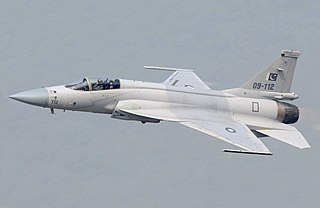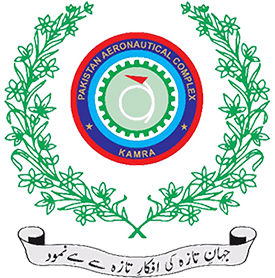
The Saab 35 Draken is a Swedish fighter-interceptor developed and manufactured by Svenska Aeroplan Aktiebolaget (SAAB) between 1955 and 1974. Development of the Saab 35 Draken started in 1948 as the Swedish air force future replacement for the then also in development Saab 29 Tunnan dayfighter and Saab 32B Lansen night fighter. It featured an innovative but unproven double delta wing, which led to the creation of a sub-scale test aircraft, the Saab 210, which was produced and flown to test this previously-unexplored aerodynamic feature. The full-scale production version entered service with frontline squadrons of the Swedish Air Force on 8 March 1960. It received the designation Flygplan 35 and was produced in several variants and types, most commonly as a fighter type with the prefix J, standing for Jaktflygplan (Pursuit-aircraft), the Swedish term for fighter aircraft.

The Hongdu JL-8, also known as the Karakorum-8 or K-8 for short, is a two-seat intermediate jet trainer and a light attack aircraft designed in the People's Republic of China by China Nanchang Aircraft Manufacturing Corporation. The primary contractor is the Hongdu Aviation Industry Corporation.

The Douglas A-4 Skyhawk is a single-seat subsonic carrier-capable light attack aircraft developed for the United States Navy and United States Marine Corps in the early 1950s. The delta-winged, single turbojet engined Skyhawk was designed and produced by Douglas Aircraft Company, and later by McDonnell Douglas. It was originally designated A4D under the U.S. Navy's pre-1962 designation system.

The Aero L-39 Albatros is a high-performance jet trainer developed in Czechoslovakia by Aero Vodochody. It was designed during the 1960s as a replacement for the Aero L-29 Delfín as a principal training aircraft. It was the first trainer aircraft to be equipped with a turbofan powerplant. The type was exported to a wide range of countries as a military trainer.
Aero Vodochody is a Czech aircraft company. Its main production facilities are located at Vodochody Airport in the Prague-East District, on the municipal territories of Vodochody and Odolena Voda.

The Mikoyan MiG-29M is a Russian multirole fighter developed in 2005. It is based on unified platform together with Mikoyan MiG-29K. The predecessor of the MiG-29M was designed by Mikoyan Design Bureau in the Soviet Union during the mid-1980s and was known as "MiG-33" during the 1990s.

The Sukhoi Su-17 is a variable-sweep wing fighter-bomber developed for the Soviet military. Its NATO reporting name is "Fitter". Developed from the Sukhoi Su-7, the Su-17 was the first variable-sweep wing aircraft to enter Soviet service. Two subsequent Sukhoi aircraft, the Su-20 and Su-22, have usually been regarded as variants of the Su-17.

The Aero L-29 Delfín is a military jet trainer developed and manufactured by Czechoslovakian aviation manufacturer Aero Vodochody. It is the country's first locally designed and constructed jet aircraft, as well as likely being the biggest aircraft industrial programme to take place in any of the Council for Mutual Economic Assistance (COMECON) countries except the Soviet Union.

The Aero L-59 Super Albatros is a Czechoslovak military jet trainer developed from the firm's earlier L-39 Albatros. Compared to its predecessor, it featured a strengthened fuselage, longer nose, a vastly updated cockpit, advanced avionics, and a more powerful engine Lotarev DV-2. At the time of its first flight on 30 September 1986, it was designated the L-39MS. Aero no longer produces this aircraft.

The Iraqi Air Force is the aerial warfare service branch of the Iraqi Armed Forces. It is responsible for the defense of Iraqi airspace as well as the policing of its international borders. The IQAF also acts as a support force for the Iraqi Navy and the Iraqi Army, which allows Iraq to rapidly deploy its military. It is headquartered in Baghdad; the current commander is Gen. Shihab Jahid Ali.

The PAC JF-17 Thunder, or CAC FC-1 Xiaolong, is a lightweight, single-engine, fourth-generation multi-role combat aircraft developed jointly by the Pakistan Aeronautical Complex (PAC) and the Chengdu Aircraft Corporation (CAC) of China. It was designed to replace the ageing A-5C, F-7P/PG, Mirage III, and Mirage V combat aircraft in the Pakistan Air Force (PAF). The JF-17 can be used for multiple roles, including interception, ground attack, anti-ship, and aerial reconnaissance. The Pakistani designation "JF-17" stands for "Joint Fighter-17", with the "-17" denoting that, in the PAF's vision, it is the successor to the F-16. The Chinese designation "FC-1 Xiaolong" stands for "Fighter China-1 Fierce Dragon".

The IAR 99 Șoim (Hawk) is an advanced trainer and light attack aircraft capable of performing close air support and reconnaissance missions. The IAR 99 replaced the Aero L-29 Delfin and Aero L-39 Albatros as the jet trainer of the Romanian Air Force. The aircraft is of semi-monocoque design, with tapered wings and a swept-back tail unit. A large blade-type antenna installed beneath the nose on the port side of the fuselage gives the IAR 99 trainer a distinctive appearance.

The Czech Air Force is the air force branch of the Army of the Czech Republic. Along with the Land Forces, the Air Force is the major Czech military force. With traditions of military aviation dating back to 1918, the Czech Air Force, together with the Slovak Air Force, succeeded the Czechoslovak Air Force in 1993. On 1 July 1997, the 3rd Tactical Aviation Corps and the 4th Air Defence Corps of the Czech Army were merged to form an independent Air Force Headquarters.

The Pakistan Aeronautical Complex, or PAC) is a major defense contractor and an aerospace manufacturer that is headquartered in Kamra, Punjab, Pakistan.

The Hongdu L-15 Falcon is a supersonic advanced jet trainer and light combat aircraft developed by Hongdu Aviation Industry Corporation (HAIC). It is used by the People's Liberation Army Air Force (PLAAF) as a lead-in fighter trainer (LIFT).

Project ROSE was a program initiated by the Pakistan Air Force (PAF) at their Pakistan Aeronautical Complex for the upgrades of the military avionics and electronics system of its aging Mirage III fighter jets, which had been built in either France or in Australia. The program focused on modernization of military avionics and on-board computer system of Mirage IIIE and the Mirage 5 supplied by Pakistani Margella Electronics, French SAGEM and the Italian SELEX consortiums, as part of the program.

A large number of variants of the General Dynamics F-16 Fighting Falcon have been produced by General Dynamics, Lockheed Martin, and various licensed manufacturers. The details of the F-16 variants, along with major modification programs and derivative designs significantly influenced by the F-16, are described below.
Draken International, LLC is an American provider of tactical fighter aircraft for contract air services including military and defense industry customers. The firm is based at the Lakeland Linder International Airport in Lakeland, Florida and also has an operating base at Nellis Air Force Base in Nevada.

The Aero L-39NG is a Czech turbofan-powered military trainer and light combat aircraft currently under development by Aero Vodochody. It is a successor of the Cold War era Aero L-39 Albatros. The aircraft is being developed in two versions (stages). While the L-39NG Stage 1 is an upgrade of original L-39 airframes with a new engine and avionics, the Stage 2 are newly built aircraft with several design improvements such as a wet wing without the type's distinctive wingtip fuel tanks. Serial production should have begun in 2019.
The Grifo radar is a family of airborne radars developed by Italian firm Leonardo S.p.A. for fighter aircraft and attack aircraft, and this family of radars includes several series.


























